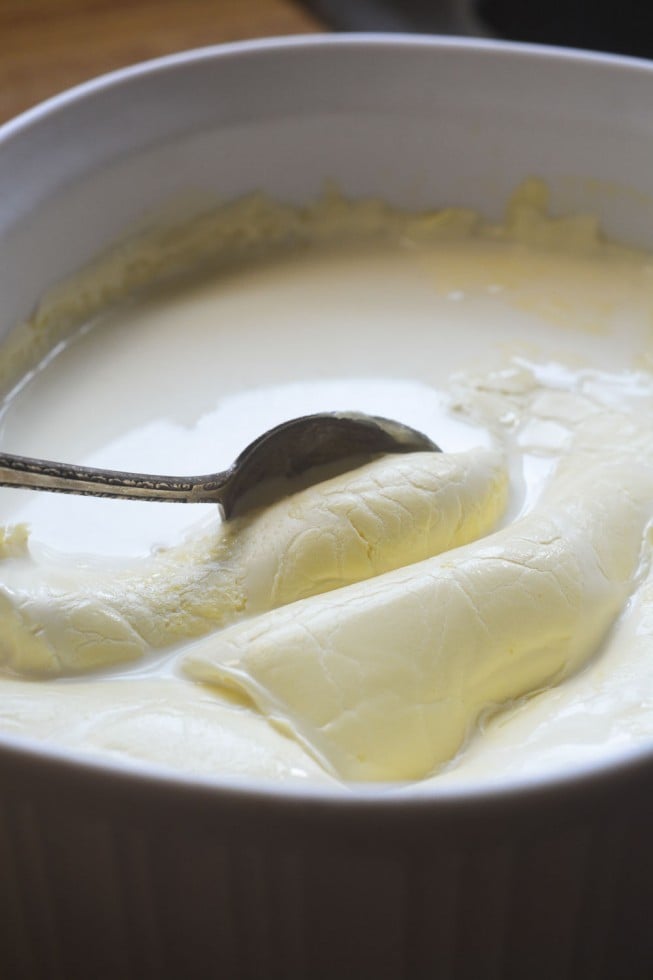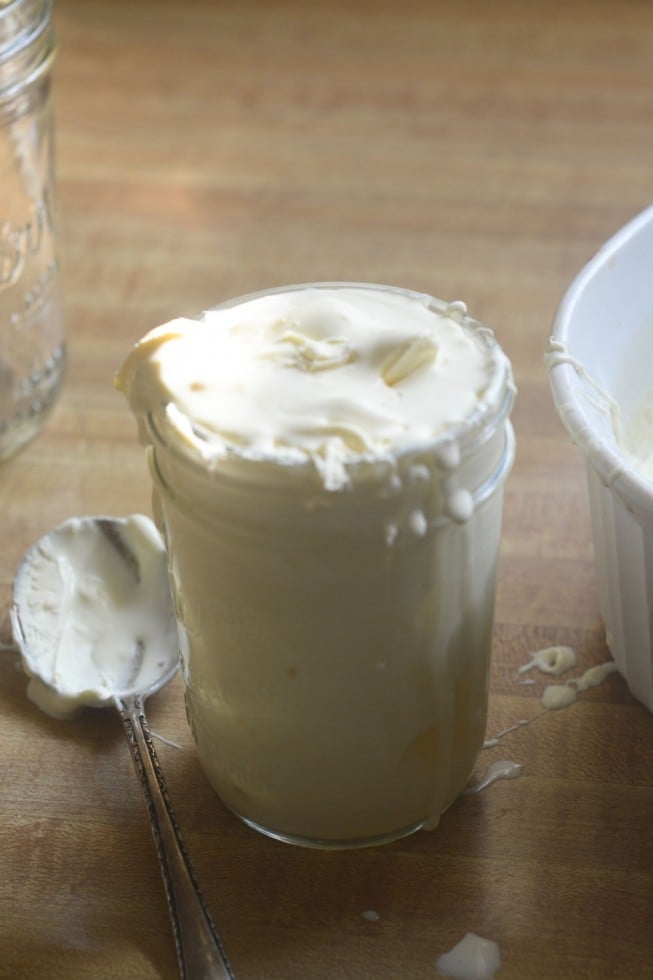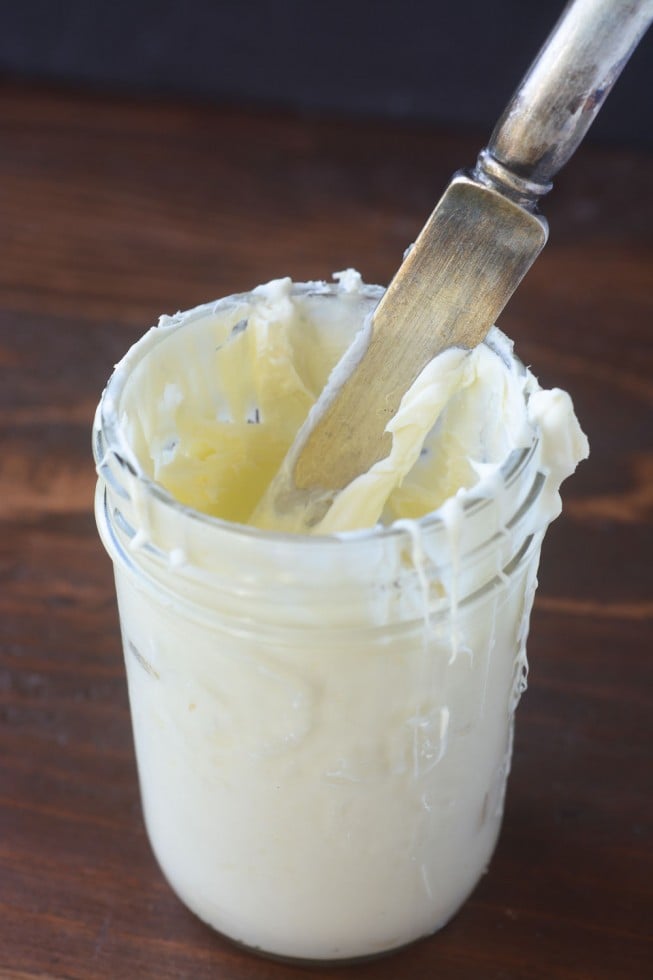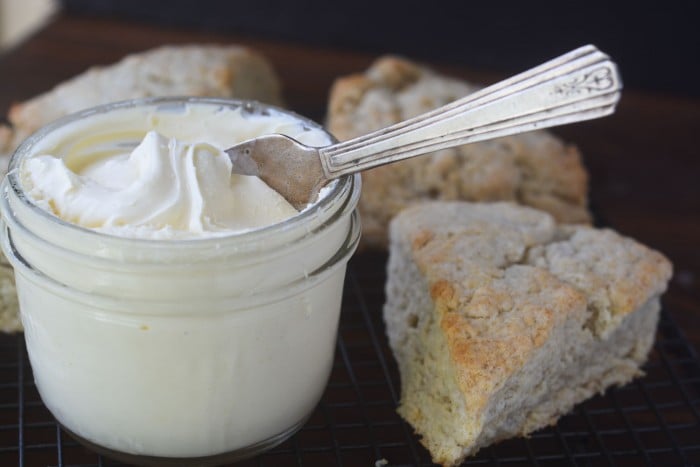“I have a British background and I have always had tea and something sweet. First time I tried this clotted cream I almost ate the entire jar by itself, it is that good!” ~Kim

If you’ve never had a classic English afternoon tea with scones and clotted cream, you’re missing out!
Last week I was treated by the historic Biltmore Hotel in downtown Los Angeles to their classic English afternoon tea. If you’ve never had a classic afternoon tea, you need to experience it. The highlight of any afternoon tea, besides the tea, is the array of tiny treats that comes with it, and I always zero right in on the scones and clotted cream. (That’s them on level two of our 3 tiered tea tray.)

What is Clotted cream?
If you’ve never had it, clotted cream is a very thick rich spreadable form of heavy cream that was first invented ages ago by some very smart British farmers. Traditionally cream heated until it thickens and develops a slightly nutty flavor. Clotted cream has a high fat content (around 55-65%) and a dense texture. It’s not like whipped cream, or cream cheese, it’s not like butter…it has a unique decadent consistency and a wonderful soft flavor. It’s quite thick and spreadable, and when you slather it on a freshly baked scone there is no better thing in the world.
The little pot of clotted cream that we got at the Biltmore had me craving more, and happily I made the most astounding discovery…you can actually make clotted cream at home in your own kitchen. No more tracking it down in specialty stores and paying big bucks for the imported stuff. My homemade clotted cream was actually way better (and a whole lot fresher) than the British stuff I usually buy.

What does clotted cream taste like?
Clotted cream has a rich, creamy taste with a slightly nutty ‘cooked’ flavor. It’s luxurious and indulgent, with a dense, velvety texture that is thicker and creamier than regular whipped cream. Clotted cream is also slightly sweet, but not as sweet as whipped cream or frosting, with a delicate flavor that pairs well with desserts, fruit, and scones. The crust on top of the clotted cream adds a slightly caramelized and nutty flavor, which many people find particularly delicious. The mouthfeel of clotted cream is a key part of its charm, and is like nothing else you’ve ever had!
what you’ll need
- heavy or whipping cream that has not been ultra-pasteurized
- This is cream that has been pasteurized, but not ultra-pasteurized. Ultra-pasteurized cream is cream that has been heated to a higher temperature than regular pasteurized cream to extend its shelf life.

How to make clotted cream
This is an amazing process, I hardly had to do anything, and I end up with a ton of the richest, silkiest clotted cream I’ve ever had.
- I used 2 pints of (non-ultra-pasteurized) heavy cream.
- I poured them into a baking dish, and left it overnight in a 180F oven (the lowest my oven will go.)
- In the morning I let it cool and then refrigerated it for the rest of the day.
- Then I scooped it into jars, which was a little sloppy at first, and put them back in the refrigerator. Any little bit of liquid gets absorbed right into the clotted cream after you put it in the jars, and by the next morning when I had it with my scones, it was absolutely to die for.

How long does clotted cream last?
Homemade clotted cream can last for up to 3-4 days when stored properly in the refrigerator. To extend its shelf life, it’s important to keep it in an airtight container and store it in the coldest part of the refrigerator, such as the back of the bottom shelf.
It’s important to note that clotted cream does not have any preservatives, so it should be consumed as soon as possible for the best flavor and texture. If you notice any changes in color, texture, or odor, discard the clotted cream immediately as it may have spoiled.

What to do with the leftover whey from making clotted cream
The leftover whey from making clotted cream can be used in a variety of ways:
- Adding it to smoothies or protein shakes for a boost of protein and nutrients.
- Using it as a substitute for milk or water in baking recipes such as bread, muffins, and pancakes.
- Using it as a marinade for meat or fish to tenderize and add flavor.
- Adding it to soups or stews for added richness and flavor.
- Using it as a liquid base for making homemade ricotta cheese or other soft cheeses.
- Feeding it to pets, as it is a good source of protein and nutrients for animals.
Note: It’s important to keep in mind that the leftover whey should be used or stored promptly to avoid spoilage. It can be stored in the refrigerator for up to a week or frozen for longer storage.

I can’t say enough good things about this project, the results far exceeded my expectations and it was absurdly easy. The only catch is that you can’t use ultra-pasteurized cream, which is cream that’s been processed for a longer shelf life. Many stores only sell ultra-pasteurized cream, so you have to search a bit for regular cream. I found mine at Whole Foods. Just read the labels… if it doesn’t say ultra-pasteurized on the label, you’re good to go.
can you make clotted cream with ultra-pasteurized cream?
Some readers in the comments below have had success with ultra-pasteurized cream. It is possible to make clotted cream from ultra-pasteurized cream, but it may be more difficult to achieve the desired texture and flavor. Ultra-pasteurization is a process that heats the cream to a higher temperature than regular pasteurization, which extends its shelf life but can also alter the proteins and enzymes in the cream. This can make it more difficult for the cream to form clots, which are necessary for making clotted cream.

What to eat with your homemade clotted cream
You will definitely want to make scones to go with your homemade clotted cream. I have lots of recipes for scones on the blog, but a simple one to start with is my Classic Cream Scones Recipe.

Tips for making clotted cream
- Make sure your cream is not ‘ultra pasteurized’, you will need to find regular pasteurized cream at a Whole Foods or other similar store. Ultra pasteurized cream has been treated in a way that prevents it from ‘clotting’.
- An oven thermometer is an essential kitchen tool, and really comes in handy for this project. If your oven is too cool or too hot your homemade clotted cream will not ‘clot’. Set your oven to 180F and then check the thermometer. You can adjust up or down as necessary.
- If your oven does not go down as low as 180F you can try one of my other methods for making clotted cream:

Homemade Clotted Cream
Video
Equipment
- a heavy casserole dish
Ingredients
- 2 pints heavy cream or whipping cream (double cream in the UK), avoid ultra-pasteurized cream for best results.
Instructions
- set your oven to 180F
- Pour the cream into the casserole dish. It should come up about 1-3 inches on the side.
- Set the dish, uncovered, in the oven and leave undisturbed for 12 hours. Be sure to leave the oven on the whole time. I do this overnight.
- Remove the dish from the oven and set to cool. Then cover and refrigerate. Note: the cream may seem thin at this point, but is going to thicken considerably overnight.
- The next morning scoop the thickened cream into a jar or jars, and cover and put back in the refrigerator. You can use the leftover cream for baking..
- Spread the clotted cream on freshly baked scones.
Nutrition























I made my clotted cream with ultra pasteurized cream. I preheat oven to 320, put dish with cream in oven. Turn oven off. Let sit for exactly 10 hours. Put plastic wrap around and put in fridge overnight. Perfection!
Great to know, thanks so much Andrea ~ I’m going to try it!
Andrea Russel, could elaborate on your process for making the clotted cream ? What is the end result like in the pan ? And after your refrigerate it ?
I do not really feel like purchasing heavy cream and ending up wasting half or even a third of it because it is mainly liquid. All the recipes I have read end up, having half the cream still liquid. It feels like such a waste in my mind.
Thank you
reuse it in your scones.
Yes!
This method never works for me because of cheap ovens letting heat out too quickly! I wish it did…
SO RELIEVED TO SEE THIS POST. FINDING NON – ULTRAPASTEURISED CREAM AROUND HER IS A CHORE!
I tried this and after refrigerating, I noticed the cream separated. I went to put it into jars and the cream didn’t clott. It clotted a little bit under the crust but the rest was still liquid. Perhaps I did something wrong?
I noticed that the lid was on when you took it out to cool. Did you leave the lid on for the whole 12 hours in the oven? Also did you leave the lid on for the cooling time? This is my first time to try to make clotted cream. This is Saturday and I have to have it to a tea party on Monday. I have no time to waste. Should have done a trial run. I’m using an 8×8 glass casserole dish. Is that ok?
Some people leave the lid on, some off. I don’t usually leave it on, but you can do either way. You can leave the lid on for cooling.
HELP! I think i pulled it out too early. All i had on top was a thin hard layer and the rest is liquid… Am I able to put it back in the oven or will that completely ruin it? ? do i need to start over completely?
* this is my first time trying to make it.
Not sure since I can’t see it, Kayla. Your oven temp might have been too high. It should have a crust on top, and when it chills overnight in the refrigerator it thickens up. You will be left with a quantity of thin whey that gets drained off. If yours doesn’t have any thick cream under that crust, you could try putting it back in the oven for several more hours.
Hello Sue,
My question is ,is it necessary to remove the crust from the clotted cream once you have completed the process and placing in your jar? what are some uses for the crust? I’d like to use all of this yummy stuff and not waste any.
Generally you should use the crust, it’s part of the clotted cream and I stir it right in.
I tried this recipe yesterday, and while it smells delightful, it developed a bit more of a yellowed crust than yours. I thought i was using the right size pan, but am wondering if i didn’t have it deep enough?
The yellowish crust is totally right, Megan, what you do is refrigerate, then stir the whole lot together, draining off any excess whey. Some authentic clotted cream is quite yellow on top when it’s ready.
Is there a way to remove the yellow crust? It left the cream very gritty and not very pleasant. Also, I am making a new batch using my crock pot which on warm is only about 140 degrees. Do you know if that is hot enough to be safe? I think you can slow pasturize milk at 145. Thank you!
You can life the crust off before you stir your clotted cream Ann. I’m not sure about the 140 degrees, as I’ve only been successful at the 180, but I’d love to hear how that goes for you.
I did an experiment using a little lunch bag warming oven (recently purchased) that I use at work as I don’t like to use the microwave. I wanted to see if I could make clotted cream in this puppy. It worked way beyond my wildest hopes. The heating plate used in the “oven” does not go above 165F. So at 8 AM on a Saturday, I poured a pint of pasteurized (not ultra) into a 6-cup Pyrex square dish (uncovered) and let it heat in the little low temp oven for 12 hours while I went about my business. After unplugging the device and letting it cool a while, I put the (now-covered) dish in the fridge overnight. In the morning, I awoke to 12 ounces of dreamy thick clotted cream and 4 ounces of the liquid. That is a pretty efficient yield! I have not mentioned the specific device as I don’t intend to push any product. Any similar device that holds a low-hot temp should work. My experiment made just the right amount of clotted cream and I did not have to tie up my kitchen oven or slow cooker. It also demonstrates that you do not have to keep a steady 180F for a successful result. It was really fun to try this out and the lovely clotted cream was my reward! Cheers!!!!
Hooray ~ I’ve never seen the type of little oven that you mention, but it sounds like it’s just the ticket for this recipe. Enjoy your clotted cream 🙂
Hello, what device did you use?
I so want to try this. I’ve called all the specialty stores up to two hours away. Not one has cream that isn’t ultra pasteurized. 🙁 I’m tempted to try it with what I can get to see if it works.
It is so frustrating, Kathy, regular cream has become a thing of the past in lots of places. I will see what I can do to create a clotted cream recipe with ultra-pasteurized cream!
How will we know if the item is ultra pasteurized or not? Will it say on the container? I don’t live in the US…no Whole Foods for me…
Here in the US it says plainly on the container, Monika. Depending on where you live, it may not say, or your cream may not be routinely ultra-pasteurized. I would suggest asking your grocer.
Just wanted to say that our first attempt worked perfectly. Thanks so much for your recipie. Now, about our waistlines …….
Yay ~ that’s great to hear, Janet ~ and as for your waistline, just be sure to share your clotted cream with friends 😉
I just made this last nite and unfortunately was unsuccessful. After reading the comments, I realized that a deep baking dish and having a thermometer to check my oven temperature might help… so I will have to try this again. But I was wondering if clotted cream needs to be baked at 12 hours or can the time be shorten? Here’s the results I had: the top had a thick golden brown crusty layer, almost like a dried caramel crust. The bottom underneath was completely liquefied with a separation of fat from the cream at top. It was in the oven overnight. Before I went to bed (approx. 2 hours in), I took a peek with the oven light on… and it already looked like clotted cream. It was thick, raised and very little liquid… would it take that quick to make clotted cream? I used a shallow glass baking casserole dish, approx. 1 inch cream deep and the oven was on my lowest setting… 170 degrees. Should I have taken it out after 2 hours? I used organic heavy cream, pasteurized from Trader’s Joe. I was going to make the clotted cream 3 days ago but had already poured only 1 pint of the heavy cream in the glass casserole dish and realized it was too shallow. So I left that in the baking dish for a few days in the fridge until I could get another pint of heavy cream. I’m just wondering if there is any variation that it could “cook” faster under different circumstances by any chance… does anyone know?
I think maybe the shallow cream level was the issue the first time, Karen. Either that or maybe your oven isn’t calibrated perfectly. I don’t know of a way to make the cream ‘clot’ faster, but maybe someone else can weigh in on this.
I’ve seen others heat the oven to 160C put the cream in as you did and repeatedly implore you to turn the oven off. Leave for 12 hrs or more. I did this and it worked although I forgot it was in the oven and turned the oven on the next morning and ruined it, but I could see that the method had worked.
Thanks Sue for your response! I did try this again, but with a deeper dish covered with foil… and it turned out great! I made sure the cream was 2 inch deep and I ended up using my oval ceramic pot from my crock pot (it has the removable dish… and it was great that I was able to use something without having to go out and buy another kitchenware item). Another thing, I used the water bath method — just to make sure to keep the oven temperature stable. So happy about this and the clotted cream was delicious w/ the scones I made 🙂
Karen, what is the “water bath method” please? Mine’s in the crock pot on warm as I write this. Thank you.